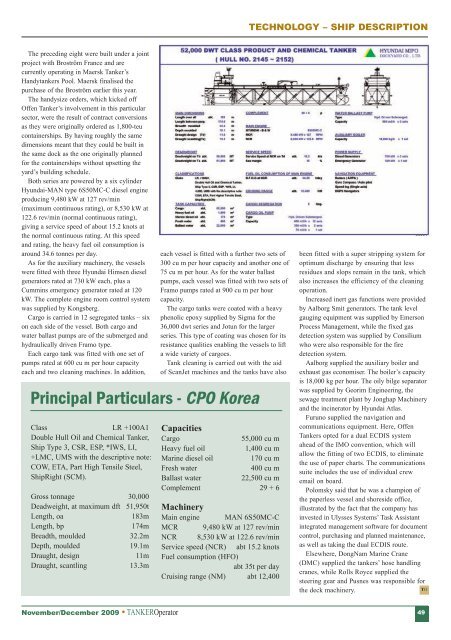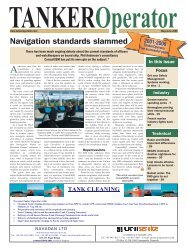Features: - Tanker Operator
Features: - Tanker Operator
Features: - Tanker Operator
Create successful ePaper yourself
Turn your PDF publications into a flip-book with our unique Google optimized e-Paper software.
TECHNOLOGY – SHIP DESCRIPTION<br />
The preceding eight were built under a joint<br />
project with Broström France and are<br />
currently operating in Maersk <strong>Tanker</strong>’s<br />
Handytankers Pool. Maersk finalised the<br />
purchase of the Broström earlier this year.<br />
The handysize orders, which kicked off<br />
Offen <strong>Tanker</strong>’s involvement in this particular<br />
sector, were the result of contract conversions<br />
as they were originally ordered as 1,800-teu<br />
containerships. By having roughly the same<br />
dimensions meant that they could be built in<br />
the same dock as the one originally planned<br />
for the containerships without upsetting the<br />
yard’s building schedule.<br />
Both series are powered by a six cylinder<br />
Hyundai-MAN type 6S50MC-C diesel engine<br />
producing 9,480 kW at 127 rev/min<br />
(maximum continuous rating), or 8,530 kW at<br />
122.6 rev/min (normal continuous rating),<br />
giving a service speed of about 15.2 knots at<br />
the normal continuous rating. At this speed<br />
and rating, the heavy fuel oil consumption is<br />
around 34.6 tonnes per day.<br />
As for the auxiliary machinery, the vessels<br />
were fitted with three Hyundai Himsen diesel<br />
generators rated at 730 kW each, plus a<br />
Cummins emergency generator rated at 120<br />
kW. The complete engine room control system<br />
was supplied by Kongsberg.<br />
Cargo is carried in 12 segregated tanks – six<br />
on each side of the vessel. Both cargo and<br />
water ballast pumps are of the submerged and<br />
hydraulically driven Framo type.<br />
Each cargo tank was fitted with one set of<br />
pumps rated at 600 cu m per hour capacity<br />
each and two cleaning machines. In addition,<br />
each vessel is fitted with a further two sets of<br />
300 cu m per hour capacity and another one of<br />
75 cu m per hour. As for the water ballast<br />
pumps, each vessel was fitted with two sets of<br />
Framo pumps rated at 900 cu m per hour<br />
capacity.<br />
The cargo tanks were coated with a heavy<br />
phenolic epoxy supplied by Sigma for the<br />
36,000 dwt series and Jotun for the larger<br />
series. This type of coating was chosen for its<br />
resistance qualities enabling the vessels to lift<br />
a wide variety of cargoes.<br />
Tank cleaning is carried out with the aid<br />
of ScanJet machines and the tanks have also<br />
Principal Particulars - CPO Korea<br />
Class LR +100A1<br />
Double Hull Oil and Chemical <strong>Tanker</strong>,<br />
Ship Type 3, CSR, ESP, *IWS, LI,<br />
+LMC, UMS with the descriptive note:<br />
COW, ETA, Part High Tensile Steel,<br />
ShipRight (SCM).<br />
Gross tonnage 30,000<br />
Deadweight, at maximum dft 51,950t<br />
Length, oa<br />
183m<br />
Length, bp<br />
174m<br />
Breadth, moulded 32.2m<br />
Depth, moulded 19.1m<br />
Draught, design<br />
11m<br />
Draught, scantling 13.3m<br />
Capacities<br />
Cargo<br />
55,000 cu m<br />
Heavy fuel oil<br />
1,400 cu m<br />
Marine diesel oil 170 cu m<br />
Fresh water<br />
400 cu m<br />
Ballast water<br />
22,500 cu m<br />
Complement 29 + 6<br />
Machinery<br />
Main engine MAN 6S50MC-C<br />
MCR 9,480 kW at 127 rev/min<br />
NCR 8,530 kW at 122.6 rev/min<br />
Service speed (NCR) abt 15.2 knots<br />
Fuel consumption (HFO)<br />
abt 35t per day<br />
Cruising range (NM) abt 12,400<br />
been fitted with a super stripping system for<br />
optimum discharge by ensuring that less<br />
residues and slops remain in the tank, which<br />
also increases the efficiency of the cleaning<br />
operation.<br />
Increased inert gas functions were provided<br />
by Aalborg Smit generators. The tank level<br />
gauging equipment was supplied by Emerson<br />
Process Management, while the fixed gas<br />
detection system was supplied by Consilium<br />
who were also responsible for the fire<br />
detection system.<br />
Aalborg supplied the auxiliary boiler and<br />
exhaust gas economiser. The boiler’s capacity<br />
is 18,000 kg per hour. The oily bilge separator<br />
was supplied by Georim Engineering, the<br />
sewage treatment plant by Jonghap Machinery<br />
and the incinerator by Hyundai Atlas.<br />
Furuno supplied the navigation and<br />
communications equipment. Here, Offen<br />
<strong>Tanker</strong>s opted for a dual ECDIS system<br />
ahead of the IMO convention, which will<br />
allow the fitting of two ECDIS, to eliminate<br />
the use of paper charts. The communications<br />
suite includes the use of individual crew<br />
email on board.<br />
Polomsky said that he was a champion of<br />
the paperless vessel and shoreside office,<br />
illustrated by the fact that the company has<br />
invested in Ulysses Systems’ Task Assistant<br />
integrated management software for document<br />
control, purchasing and planned maintenance,<br />
as well as taking the dual ECDIS route.<br />
Elsewhere, DongNam Marine Crane<br />
(DMC) supplied the tankers’ hose handling<br />
cranes, while Rolls Royce supplied the<br />
steering gear and Pusnes was responsible for<br />
the deck machinery.<br />
TO<br />
November/December 2009 TANKER<strong>Operator</strong> 49

















